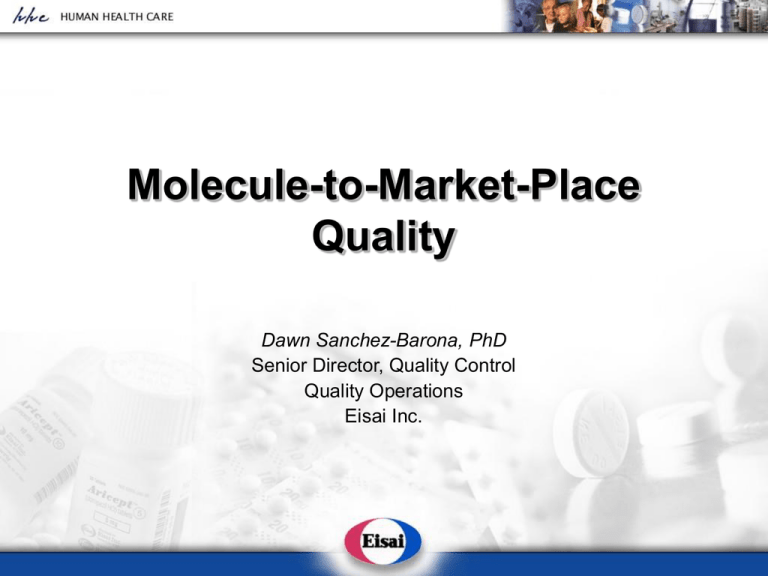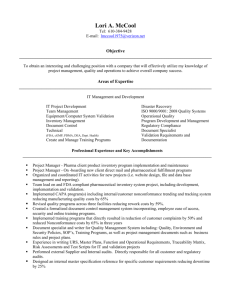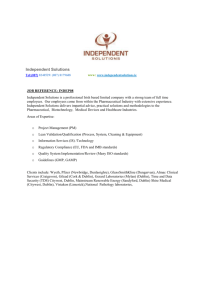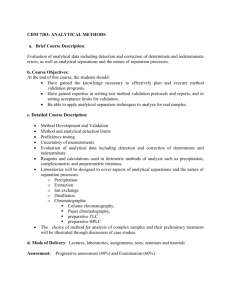Molecule-to-Market-Place Quality Dawn Sanchez-Barona, PhD Senior Director, Quality Control
advertisement

Molecule-to-Market-Place Quality Dawn Sanchez-Barona, PhD Senior Director, Quality Control Quality Operations Eisai Inc. Overview Role of Quality Operations Principles of Quality Management Example of Quality Operations Organization Responsibilities of Each Quality Department Quality Operations in Pharmaceutical and Analytical Development Quality Strategy in Pharmaceutical Development References Q7A – Good Manufacturing Practice Guide for Active Pharmaceutical Ingredients Q8 – Pharmaceutical Development Q9 – Quality Risk Management The Gold Sheet, Vol. 40, August 2006 www.ich.org www.FDA.gov/cder/handbook/development.htm Role of Quality Operations Ensure (Eisai) patients receive clinical or commercial products that are safe, pure, and fit for their intended use, and comply with all regulatory requirements. Principles of Quality Management All persons involved in manufacturing pharmaceutical products are responsible for quality. Each manufacturer should establish, document, and implement an effective system for managing quality that requires the commitment and active participation of management and staff at all levels in the company – as well as the company’s suppliers, contractors, and distributors. There should be a quality unit(s) that is independent of production and that fulfills the quality assurance (QA) and quality control (QC) responsibilities. Quality-based decisions are based on sound scientific judgment and evaluation and require defined processes to implement. Example of Quality Operations Organization Manufacturing QA Clinical QA QC Validation Responsibilities – Manufacturing QA Broadly responsible for implementation and adherence to GMPs, product disposition, and quality systems associated with these functions: • • • • • • • • • • • • Document Control Auditing/Vendor Certification Training Product Dispositions Deviations/Investigations/Corrective Actions/Preventative Actions Change Control Label Review and Disposition Reserve/Retain Sample Management Complaints Trending Annual Product Reviews Contract Manufacturing Organizations Responsibilities – QC Broadly responsible for laboratory controls associated with product disposition and quality systems required for this function: • • • • • • • • • • Sampling/Disposition Raw Materials and Packaging Components GMP Laboratory Management Release Testing Stability Testing and Program Management Document Control/Evaluation Out-of-Specification Investigation Reference Standard Management Analytical Technology Transfer/Validation Analytical Evaluation of Post-Market Changes Investigation Support Responsibilities – Validation Broadly responsible for establishing a validation program and compliant documentation and execution of all qualification and validation activities, including: • • • • • • Equipment Qualification Computer System Validation Cleaning Validation Process Validation Periodic Review of Validated Systems Risk Assessment Responsibilities – Clinical QA Broadly responsible for ensuring clinical trials are conducted in accordance with GCPs, and that data are generated, documented, and reported accurately and in compliance with all applicable regulatory requirements. Quality Manufacturing QA Validation Clinical QA QC Quality Operations in Pharmaceutical and Analytical Development The New Drug Development Process Steps from Test Tube to New Drug Application Review Quality Operations in Pharmaceutical and Analytical Development Goals are same; i.e, role of Quality Operations and principles of Quality Management does not change. Tactics for implementing quality can be different. Controls used in the manufacture of active pharmaceutical ingredients (APIs) and drug products should be consistent with the stage of development. Process and test procedures should be flexible to provide for changes as knowledge of the process increases, and clinical testing of a drug product progresses from pre-clinical through clinical stages. Responsibilities – Manufacturing QA Broadly responsible for implementation and adherence to GMPs, product disposition, and quality systems associated with these functions: • • • • • • • • • • • • Document Control Auditing/Vendor Certification Training Product Dispositions Deviations/Investigations/Corrective Actions/Preventative Actions Change Control Label Review and Disposition Reserve/Retain Sample Management Complaints Trending Annual Product Reviews Contract Manufacturing Organizations Responsibilities – Analytical Development Testing functions commonly performed by QC can be performed within other organizational unit, such as Analytical Development (AD). In this example, AD would be broadly responsible for laboratory controls associated with clinical product disposition and quality systems required for this function: • • • • • • • • • • Sampling/Disposition Raw Materials and Packaging Components GMP Laboratory Management Release Testing Stability Testing and Program Management Document Control/Evaluation Out-of-Specification Investigation Reference Standard Management Analytical Technology Transfer/Validation Analytical Evaluation of Post-Market Changes Investigation Support Responsibilities – Validation Broadly responsible for establishing a validation program and compliant documentation and execution of all qualification and validation activities, including: • • • • • • Equipment Qualification Computer System Validation Cleaning Validation Process Validation Periodic Review of Validated Systems Risk Assessment Quality Strategy in Pharmaceutical Development Theme – Quality by Design (QbD) Knowledge of process (design space) Identification of steps critical to quality of drug substance or drug product Control strategies for synthesis/formulation choices justified Background PD Goal – Design a quality product and manufacturing process to consistently deliver the intended performance of the product. Information and knowledge gained from pharmaceutical development studies provide: Scientific basis for establishing the formulation design space, specifications, and manufacturing controls Rationale for quality risk management Background Design Space Multidimensional combination and interaction of input variables (e.g., material attributes) and process parameters that have been demonstrated to provide assurance of quality. Proposed in (NDA) filing and subject to regulatory (FDA) assessment. Working within design space not considered a change. Movement out of design space considered a change and would initiate a typically regulatory post-approval filing. Establishing Design Space: Gains Creates higher degree of understanding of material attributes, manufacturing processes and their controls within your company and with FDA. Facilitates understanding of differences between the manufacturing processes used to make drug product for pivotal clinical trials/stability studies and vs. commercial product Provides potential opportunities for risk-based regulatory decisions (reviews and inspections) Facilitates manufacturing process improvements without further regulatory review (if stay within design space) and may reduce number of post-approval submissions Provides potential for real-time quality control and reduction of end-product (QC) release testing Establishing Design Space: Challenges Establishing appropriate/expected level of detail in regulatory submissions Establishing balance between QbD-based vs. traditional demonstration of quality Achieving regulatory flexibility while assuring product quality Sharing proprietary information with FDA FDA pilot program – more work to be done!





